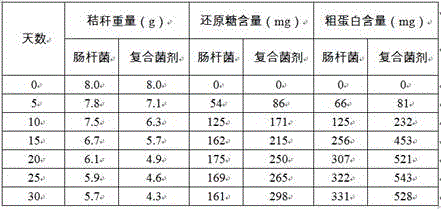Composite microbial agent capable of degrading agricultural wastes
A technology of agricultural waste and compound microbial inoculants, applied in the field of microorganisms, can solve the problems of high energy consumption by physical methods, weak cold resistance, secondary pollution by chemical methods, etc., achieve significant economic and social benefits, avoid soil compaction, animal good palatability
- Summary
- Abstract
- Description
- Claims
- Application Information
AI Technical Summary
Problems solved by technology
Method used
Image
Examples
Embodiment 1
[0015] Embodiment 1: preparation process of composite bacterial agent
[0016] A kind of microbial compound bacterial agent, is made of Enterobacteriaceae ( Enterobacter sp. ), Comamonas ( Comamonas serinivorans ), Rhodococcus ( Rhodococcus sp. ) and Bacillus ( Bacillus ligniniphilus )composition.
[0017] The mass percentage of each component is: Enterobacter 20%-30%, Comamonas 30%-40%, Rhodococcus 10%-20%, Bacillus 20%-40%.
[0018] Wherein, enterobacteria described in this embodiment ( Enterobacter sp. )YC105C, was deposited in China General Microorganism Culture Collection Center on March 20, 2014, with the preservation number CGMCC No.8941, and has applied for a patent (application number 201510010882.4).
[0019] Comamonas ( Comamonas serinivorans ) C35, which was deposited in the Japan Culture Collection of Microorganisms on April 15, 2014, with a preservation number of JCM No. 18194, and its isolation, screening and identification process is detailed in ...
Embodiment 2
[0025] Example 2: Composite microbial agent for degrading corn stalks
[0026] Inoculate 0.5 g of the compound microbial agent mixed with 25% Enterobacter, 35% Comamonas, 20% Rhodococcus, and 20% Bacillus in the corn stalk degradation medium, and culture it statically at 25°C for 30 days , detect the quality of the remaining straw, the content of reducing sugar and crude protein in the medium, and culture under the same conditions after inoculation with 0.5 g of pure Rhodococcus inoculum as a comparison.
[0027] The components of the corn stalk degradation medium are: K 2 HPO 4 1.0 g, MgSO 4 •7H 2 O 0.3g, NaCl 0.1g, FeCl 3 0.01g, CaCl 2 0.1 g, 5 g corn stalks, 1000 mL distilled water, natural pH.
[0028] The method for measuring the weight loss rate of straw: carefully discard the supernatant of the culture solution, rinse the remaining straw several times with dilute hydrochloric acid, then rinse repeatedly with sterile water until neutral, filter, dry at 60°C unt...
Embodiment 3
[0034] Embodiment 3: Composite bacteria agent for degrading wheat straw
[0035] 0.7 g of compound microbial agent mixed with 20% Bacillus, 40% Comamonas, 15% Rhodococcus and 25% Bacillus was inoculated into the wheat straw degradation medium, and cultured at 20°C for 30 days. And 0.7g of pure Enterobacteriaceae inoculum was used as a comparison.
[0036] The components of the wheat straw degradation medium are: K 2 HPO 4 1.0 g, MgSO 4 •7H 2 O 0.3g, NaCl 0.1g, FeCl 3 0.01g, CaCl 2 0.1 g, 8 g wheat straw, 1000 mL distilled water, natural pH.
[0037] All the other methods are the same as in Example 2.
[0038] The degradation effect is shown in Table 2. After 30 days of cultivation, the weight loss rate of pure Enterobacteriaceae and compound bacterial agents on corn stalks reached 29% and 46%, respectively. The degradation efficiency of the composite bacterial agent was significantly higher than that of the single bacteria Enterobacter, and the reducing sugar and c...
PUM
 Login to View More
Login to View More Abstract
Description
Claims
Application Information
 Login to View More
Login to View More - R&D
- Intellectual Property
- Life Sciences
- Materials
- Tech Scout
- Unparalleled Data Quality
- Higher Quality Content
- 60% Fewer Hallucinations
Browse by: Latest US Patents, China's latest patents, Technical Efficacy Thesaurus, Application Domain, Technology Topic, Popular Technical Reports.
© 2025 PatSnap. All rights reserved.Legal|Privacy policy|Modern Slavery Act Transparency Statement|Sitemap|About US| Contact US: help@patsnap.com



